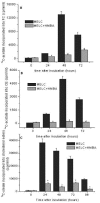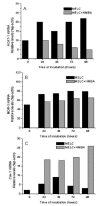Cholesterol esterification during differentiation of mouse erythroleukemia (Friend) cells
- PMID: 22184540
- PMCID: PMC3238487
- DOI: 10.4081/hr.2011.e19
Cholesterol esterification during differentiation of mouse erythroleukemia (Friend) cells
Abstract
Cholesterol is an essential constituent of all mammalian cell membranes and its availability is therefore a prerequisite for cellular growth and other functions. Several lines of evidence are now indicating an association between alterations of cholesterol homeostasis and cell cycle progression. However, the role of cholesterol in cell differentiation is still largely unknown. To begin to address this issue, in this study we examined changes in cholesterol metabolism and in the mRNA levels of proteins involved in cholesterol import and esterification (multi-drug resistance, MDR-3) and acylCoA: cholesterol acyltransferase (ACAT) and cholesterol export (caveolin-1) in Friend virus-induced erythroleukemia cells (MELC), in the absence or in the presence of the chemical inducer of differentiation, hexamethylene bisacetamide (HMBA). FBS-stimulated growth of MELC was accompanied by an immediate elevation of cholesterol synthesis and cholesterol esterification, and by an increase in the levels of MDR-3 and ACAT mRNAs. A decrease in caveolin-1 expression was also observed. However, when MELC were treated with HMBA, the inhibition of DNA synthesis caused by HMBA treatment, was associated with a decrease in cholesterol esterification and in ACAT and MDR-3 mRNA levels and an increase in caveolin-1 mRNA. Detection of cytoplasmic neutral lipids by staining MELC with oil red O, a dye able to evidence CE but not FC, revealed that HMBA-treatment also reduced growth-stimulated accumulation of cholesterol ester to approximately the same extent as the ACAT inhibitor, SaH. Overall, these results indicate for the first time a role of cholesterol esterification and of some related genes in differentiation of erythroid cells.
Keywords: cholesterol; cholesterol esterification; differentiation.; erythroleukemia.
Conflict of interest statement
Conflict of interest: the authors report no conflicts of interest.
Figures





Similar articles
-
Inducer-mediated commitment of murine erythroleukemia cells to differentiation: a multistep process.Proc Natl Acad Sci U S A. 1982 Jan;79(2):471-5. doi: 10.1073/pnas.79.2.471. Proc Natl Acad Sci U S A. 1982. PMID: 6952199 Free PMC article.
-
Conversion of differentiation inducer resistance to differentiation inducer sensitivity in erythroleukemia cells.Mol Cell Biol. 1990 Jul;10(7):3535-40. doi: 10.1128/mcb.10.7.3535-3540.1990. Mol Cell Biol. 1990. PMID: 1972544 Free PMC article.
-
Induced differentiation of murine erythroleukemia cells (MELC) by polar compounds: marked increased sensitivity of vincristine resistant MELC.Prog Clin Biol Res. 1989;316B:171-81. Prog Clin Biol Res. 1989. PMID: 2616574
-
Hexamethylene bisacetamide-induced differentiation of transformed cells: molecular and cellular effects and therapeutic application.Int J Cell Cloning. 1988 Jul;6(4):230-40. doi: 10.1002/stem.5530060402. Int J Cell Cloning. 1988. PMID: 3047266 Review.
-
Modulation of gene expression during terminal cell differentiation: murine erythroleukemia.Symp Fundam Cancer Res. 1984;37:327-40. Symp Fundam Cancer Res. 1984. PMID: 6084863 Review.
References
-
- Dessi S, Batetta B, Pulisci D, et al. Altered pattern of lipid metabolism in patients with lung cancer. Oncology. 1992;49:436–44. - PubMed
-
- Dessì S, Batetta B, Pulisci D, et al. Cholesterol content in tumor tissues is inversely associated with high-density lipoprotein cholesterol in serum in patients with gastrointestinal cancer. Cancer. 1994;73:253–8. - PubMed
-
- Dessì S, Batetta B, Pulisci D, et al. Total and HDL cholesterol in human hematologic neoplasms. Int J Hematol. 1991;54:483–6. - PubMed
LinkOut - more resources
Full Text Sources

